Friday, 3 June 2005
Distance 29 km
Duration 6 hours 15 minutes
Ascent 273 m, descent 267 m
Map 26 of the TOP 100 blue series (now superseded)
Topoguide (ref.6552), Sentiers vers Saint-Jacques-de-Compostelle via Tours
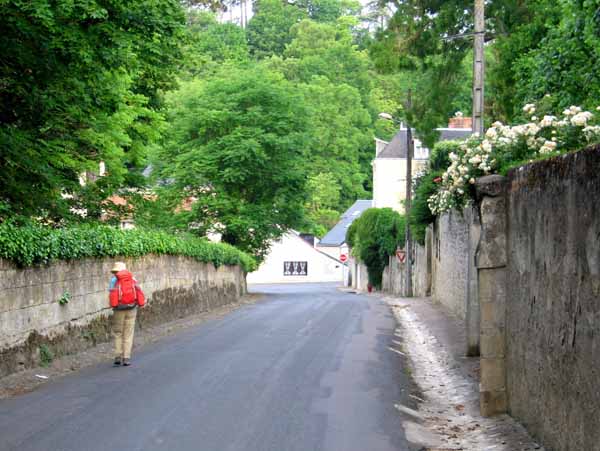
With unaccustomed promptness and without stopping for coffee, we left Vouvray on the well-marked GR3.
We walked at first through lanes lined with houses and then up a low cliff-line, past ancient dwellings embedded in the rock with their chimneys sticking up above like tree-stumps, onto the causse. This flat land was a carpet of vines under an immense sky, delightful to walk over in the coolness of the morning.
Descending the cliffs again, and crossing the highway, we picked up a footpath beside the river and followed it the rest of the way into Tours.
Looking to the left, past scrubby willows laced with driftwood, to the disorderly shallow stream weaving amongst sandbars, it was possible to imagine oneself in an age of mammoth-hunters and dolmen-builders.
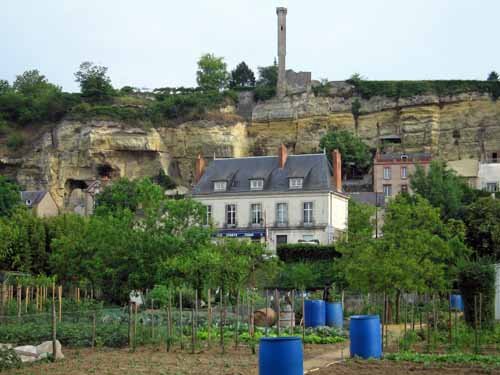
Looking to the right, a row of neat allotments stretched up to the houses, lovingly planted with vegetables, fruit trees and flowers, each with its blue water barrel. In a nation of gardeners, it is a pleasure to walk along back fences.
In due course, past the ruins of the fourth-century Abbey of Marmoutier, established by Saint Martin, the path went under a huge road-bridge, and we were in a city park, where a group of comatose teenagers lay in sleeping bags, surrounded by empty bottles.
After passing beneath another road, we came to a high footbridge (a replacement for the twelfth-century one which was washed away), and crossed the Loire in two stages, via an island, to the old centre of Tours.
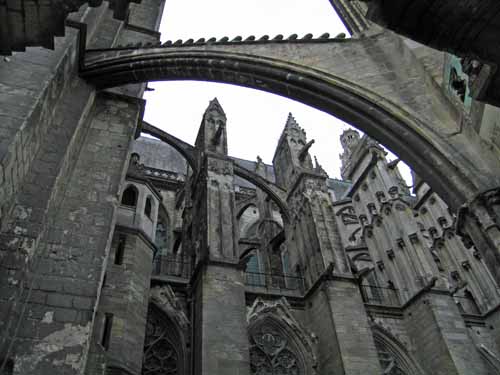
The cathedral of Saint-Gatien loomed over us. It was one of the first to be built in the Gothic style and still has great power, even hemmed in by more recent buildings as it is. The cloisters were being restored but were worth looking at.
Tours is the home of Saint Martin, one of the most energetic early disseminators of the Christian faith. He was a Roman, born into a military family in the fourth century, when Christianity was legal but still only a minor cult.
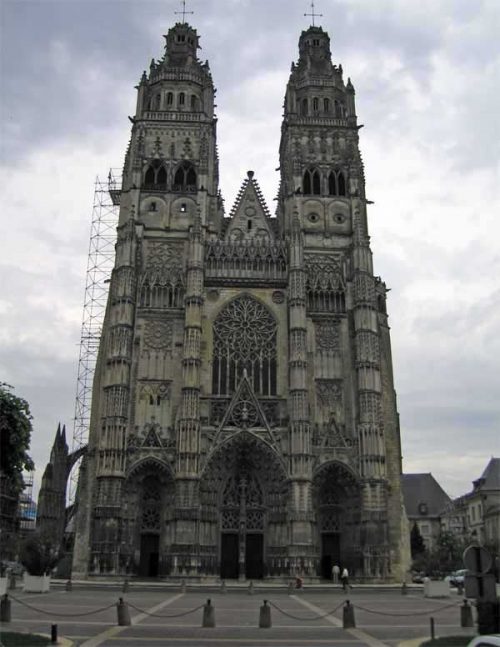
Posted to Amiens in a cavalry unit, he was confronted one day by a beggar, and impulsively cut his cloak in half to give to the shivering fellow. That night Jesus appeared to him in a dream wearing the half-cloak, and he became a whole-hearted believer.
From then on he devoted himself to the religious life and was assiduous in the conversion of the native population. Most of the Gaullish peasantry saw the error of their ways at the point of a sword, but then Saint Martin, together with later missionaries, would have said it was for their own good. He helped them along by destroying traditional shrines and holy places, and he ranged over an astonishing area of northern France in so doing.
By the time he died, Christianity was dominant in western Europe, although he was not solely responsible for this – the fact that the emperor Constantine had become a Christian may have had something to do with it. Tours was the centre of Saint Martin’s influence and remains so today, notwithstanding the many churches dedicated to him throughout western Europe.
Further on, we came to a wide, prosperous main street flocking with shoppers, and found a bar on the pavement where, with the addition of pastries from the adjoining boulangerie, we had a splendid second breakfast.
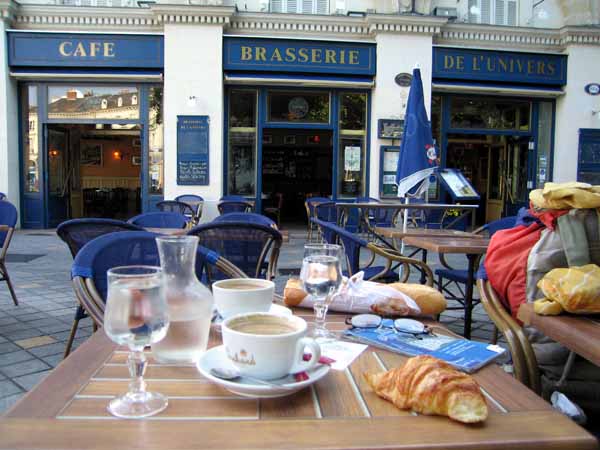
Near the railway station in another handsome boulevard, we found the Office of Tourism and not far away, an internet café, the biggest one in France, they claimed, a huge ill-lit bunker with rows and rows of screens manned by unhealthy looking mesmerised youths. From here we sent our first email of the trip and got out into the fresh air as quickly as possible.
There were other things to see in Tours, such as the medieval quarter down on the river, but we were in a hurry to press on to our destination, the outlying village of Veigné.
The next part of our walk was a lesson in what not to do. Before leaving Australia we had searched the Internet for camping grounds in Tours.
The nearest one we found was at Veigné, about 12 km from the centre of Tours. We had bought the Topoguide for the Way of Tours in Paris, but, for some reason now forgotten, did not bother to open it.
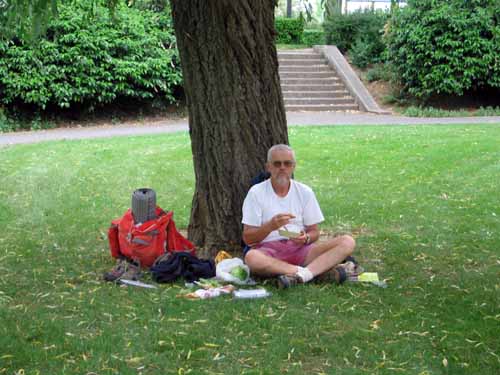
From Tours to Veigné the GR takes quite a circuitous route, so we decided to make a quick dash down the highway. This was a big mistake.
If we had checked the Topoguide we would have seen that the GR passes a camping ground and all the comforts at Saint-Avertin, only 6 km from the centre of Tours.
At first it was not too bad, as we went through suburbs with footpaths and gardens. We stopped for lunch under a willow in a little park, then the real hardship began.
The greenery gave way to barren flyovers, underpasses, cloverleafs, and general concrete spaghetti, roaring with traffic, in the midst of which we felt like tiny superseded crawling life-forms about to be extinguished by a more dynamic species.
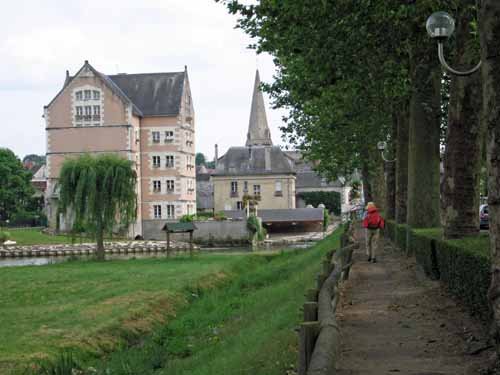
On all sides were factories, car yards and billboards, sapping our strength through their very ugliness. At last, just as we reached the turn-off from the N10 towards Veigné, there was a bar.
It had a drab look but there was a sweet little terrace at the back, tranquil and full of flowers. With our boots off and steaming coffees in front of us, we quickly regained our spirits.
The rest of the walk, while still on a road, was much calmer. By slithering down a path, we cut off the hairpin bends of the descent into the valley and found ourselves in a lovely little village on the river Indre, where a tall pink mill building stood as proud as a château.
The camping ground was on the river nearby. We booked in and were touched to be invited to sit down and have free coffee, after our unpleasant afternoon of road walking.
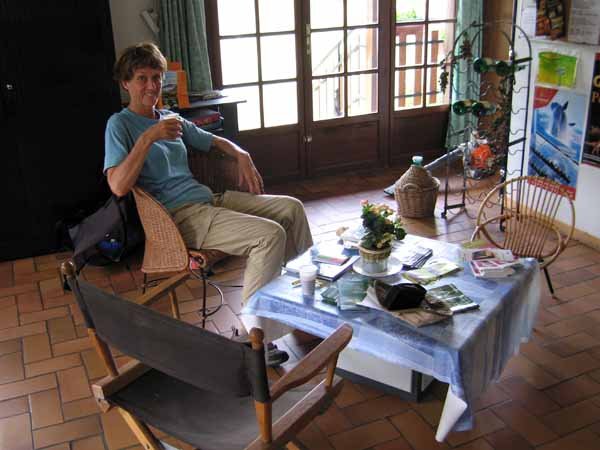
We found out that there was a restaurant and bar attached to the place, a fact that proved useful later, when we went to explore the village and found that not one of the cafés was open at night. By that time there was a solid line of cars on the street, going we knew not whither for a weekend out of Tours.
Back at the camping, we sat on a wide terrace looking over the water meadows and ordered a jug of red. The air was coolish and for dinner we moved down to a large marquee next to the river, where we had rillettes as a first course, then paella and a large salad, all much enjoyed.
We finished with execrable coffee, a phenomenon not much found in France these days.
Previous day: Amboise to Vouvray